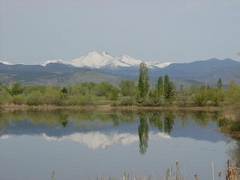You may remember the sandstone-mining ghost town of Noland, Colorado from the early 1900's in the hills above Lyons, and the fact that today it is on private property with NO TRESPASSING signs on the steep 4WD road leading up to it. Over the years, I made several attempts to get up there but none of them worked out.
That changed last summer (2017) when an interested party (I'll leave it at that) offered me a legal opportunity to visit the Noland area!
What's mostly standing up there today are some old buildings in the sandstone quarry areas. Remember that the town buildings themselves were built of wood and were deconstructed and hauled away via rail when the town faded away.
There were a few pools of standing water up there, this one even had some goldfish swimming around in it. Lack of water was one of the reasons behind the demise of Noland but these little ponds even during wetter summers could not have sustained the town.
This other pool of water had no goldfish and thus was a foul-smelling mosquito haven:
Likely some old quarrying equipment:
More difficult to see but there are old food tin cans laying around:
And lots of large piles of sandstone scraps:
Had to be careful wandering around the brush up there in the middle of summer, as this is prime rattlesnake country. Nearby Rabbit Mountain was formerly known as Rattlesnake Mountain for this very reason. More detailed exploring of this area would best be done during the cooler months.
Thanks again to the friendly "group" that arranged for me to be in the area legally. Very glad I got to see some of Noland's remains.
That changed last summer (2017) when an interested party (I'll leave it at that) offered me a legal opportunity to visit the Noland area!
What's mostly standing up there today are some old buildings in the sandstone quarry areas. Remember that the town buildings themselves were built of wood and were deconstructed and hauled away via rail when the town faded away.
There were a few pools of standing water up there, this one even had some goldfish swimming around in it. Lack of water was one of the reasons behind the demise of Noland but these little ponds even during wetter summers could not have sustained the town.
This other pool of water had no goldfish and thus was a foul-smelling mosquito haven:
Likely some old quarrying equipment:
More difficult to see but there are old food tin cans laying around:
And lots of large piles of sandstone scraps:
Had to be careful wandering around the brush up there in the middle of summer, as this is prime rattlesnake country. Nearby Rabbit Mountain was formerly known as Rattlesnake Mountain for this very reason. More detailed exploring of this area would best be done during the cooler months.
Thanks again to the friendly "group" that arranged for me to be in the area legally. Very glad I got to see some of Noland's remains.

 One citizen's view of Longmont, Colorado, USA.
One citizen's view of Longmont, Colorado, USA.













3 comments:
This is so cool! Love getting to see areas that we non-connected folks don't get to see. Thanks for sharing the photos.
Thanks. This area was actually being considered for county open space for a while but with the steep road up there, I can see why that's not really practical.
I enjoyed your story and pictures. Any Chace of getting in there to take photos and see the remains? I have 4 wheel drive.
Carol
Post a Comment